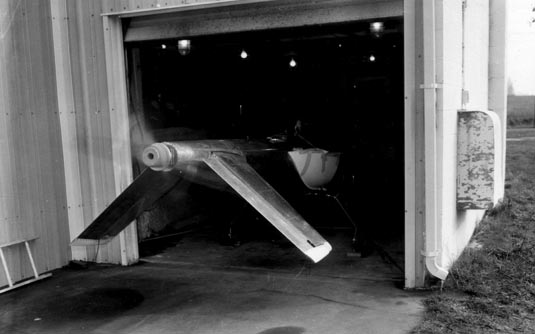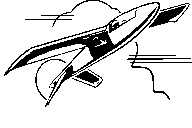









Propeller
The tail position of the Mini-IMP propeller
is extremely desirable. Not only
does it move the propeller with its noise and vibration as far away from the
pilot as possible, but it also permits the entire aircraft to “fly” in
undisturbed air. Further, the
flight controls of the aircraft are not influenced in their effectiveness by the
propeller slipstream. Thus, the
aircraft will (for all intents and purposes) stall at the same airspeed either
power ON or power OFF. The absence
of slipstream not only reduces vibration and fatigue of both the aircraft
structure and the pilot, but it also greatly reduces the drag of the aircraft
which is flying in unaccelerated air, as contrasted with the high velocity air
that goes over the fuselage and tail of conventional aircraft.
While the propeller itself may be operating in somewhat disturbed air due
to the passage of the fuselage ahead of it, and thus have a slightly lower
efficiency, the overall “system” of the aircraft/propeller arrangement is
more efficient with the tail propeller.

Aircraft
designed with the “tail” propeller must have special provisions in a number
of ways to permit attaining proper use of the propeller.
The number of tail surfaces closely ahead of the propeller greatly
influences design in this regard, and the simple two-surface arrangement of the
inverted “V” tail of the Mini-IMP is felt to be optimum.
It is essential the propeller not intercept two surface “wakes”
simultaneously, and that the wake of those surfaces closely ahead of the
propeller are kept in the proper angular relation to the propeller so as to
minimize vibration and excitation of both the propeller and the shaft system.
The design of the Mini-IMP has drawn heavily on over 25 years of
experience by the designer in working with this arrangement.
The smooth operation of the prototype and the almost complete lack of
“distress” noise from the propeller of the aircraft indicate that the system
and arrangement as shown in the drawings provides optimum performance and
capability for the design. The
thrust loads developed by the propeller are carried directly into the tail cone
by a rubber mounted thrust bearing which is self-lubricated, and the minute
bending loads due to propeller inclination and asymmetrical disc loading of the
propeller are carried into the shaft and forward to the engine where they are
resisted by the engine mounts themselves in slight sideways displacement.
These forces are known to be there and are provided for as are motions
due to thermal expansion, etc. Years
of experience and testing have gone into the system as it is provided in the
Mini-IMP, and the arrangement has been fully tested for FAA certification and
approved for unlimited life in the fully certificated AEROCARs.
Although the tail position for the propeller
does subject the propeller itself to some hazards due to debris being thrown
into the propeller by the airplane, it should be recognized that there is no
slip stream to pick up dirt and gravel. The
only real dangers are from objects picked up by the tires.
To this end, the Mini-IMP should be equipped with “slicks” with wide
profiles so as to preclude possibilities in this regard.
The drawings and Bill of Materials call out suitable tires for the use.
In an aircraft such as the Mini-IMP, which
has a bare minimum of cross section area (this is dictated by the size of the
pilot in the semi-reclined position), and which has the least number of tail
surfaces to create drag, and which utilizes the latest technology as far as wing
design is concerned to get best lift and least drag, the only remaining
consideration which can effect performance are the landing gear and the
propeller. The Mini-IMP
incorporates a fully retracting landing gear, so this leaves the propeller as
the only thing over which much further control is possible as far as getting
improved performance is concerned. Since
it is obvious that the propeller is probably the only factor over which the
builder has much control, it is apparent that the selection of the proper
propeller is very important. The
prototype is initially being flown on a hand-carved wood unit which is obviously
a compromise with its fixed pitch. However,
it is desirable to have a propeller which would at least permit the Mini-IMP
owner to select the obtainable performance under some circumstances.
Thus, at the time of this writing, a Warnke ground-adjustable propeller
has been ordered so that the propeller can be adjusted to obtain optimum
performance with some compromise both for takeoff/climb and cruise.
This propeller will permit the builder to set the unit so that he can
favor either the takeoff/climb condition or the cruise condition if he so
desires. Propeller manufacturers
all over the world are being contacted in an effort to find one that might be
interested in building a mechanically controllable propeller for the
Mini-IMP’s, and it is hoped that eventually we will have something like this
available since the propeller is so important as far as the ultimate performance
of the aircraft is concerned. With
the original propeller, the Mini-IMP is easily airborne in less than 800 feet
and “cruise” in the 150 MPH range is obtainable without exceeding the
recommended 3200 RPM cruise speed for the Limbach engine.
Higher cruise speeds are obtainable, but at the expense of exceeding
recommended engine limits. Performance
with other engines will be determined in large measure by the propellers with
which they are fitted, and whether engine limits are exceeded. It is a well-known fact that Formula One racers greatly
exceed published engine limits to get their 240 MPH plus speeds.
Whether the Mini-IMP builder wants to do this is entirely up to him.
The Mini-IMP closely approximates Formula One racers in weight and
equivalent flat plate area as far as drag is concerned, and has a retractable
landing gear which Formula One racers do not have.
However, in a effort to give it “pussy cat” characteristics, the
designer has given it sufficient wing area to give approximately 45-50 MPH
takeoff and landing speeds, although the GA(PC)-1 wing does permit the pilot to
effectively “de-camber” the wing to some extent and reduce trim drag during
cruise. It should be recognized
that if a hand carved wood propeller is going to be fitted on your Mini-IMP, and
you are going to be using some engine other than the one fitted on the
prototype, you may well have to go through several propellers before you find
the optimum diameter and pitch.
 Mini-IMP
Aircraft Company
Mini-IMP
Aircraft Company 